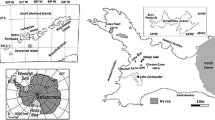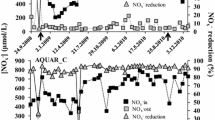Abstract
The marine methanol-fed fluidized denitrification system operated by the Montreal Biodome includes carriers on which a denitrifying biofilm has developed. Previous observations showed a high abundance of microeukaryotes living in and around the biofilm. These eukaryotes may influence the system’s denitrification efficiency. The composition of the microeukaryote population was determined. Microscopic observations showed at least 20 different morphologies that included large numbers of ciliates. Molecular analyses of an 18S ribosomal RNA (rDNA) gene library revealed 31 different phylotypes. Alveolobiontes were the most abundant phylotypes and made up 75% of the 159 screened clones. Other eukaryotic groups, including Stramenopiles, Fungi, Amoebozoa, and nematodes, were also present. From 18S rDNA specific sequences, one of the Amoebozoa-affiliated phylotypes was visualized by fluorescence in situ hybridization. It had a rod-like irregular shape and measured less than 5 μm in length. We determined the impact of protozoans on the denitrifying activity. In a laboratory-scale batch culture assays, the denitrifying biofilm was treated with cycloheximide and nystatin that eliminated the protozoans. No difference in the denitrification rate was found. However, planktonic bacteria were more abundant in the treated culture medium.







Similar content being viewed by others
References
Aleya L, Hartmann HJ, Devaux J (1992) Evidence for the contribution of ciliates to denitrification in a eutrophic lake. Eur J Protistol 28:316–321
Amann R, Lemmer H, Wagner M (1998) Monitoring the community structure of wastewater treatment plants: a comparison of old and new techniques. FEMS Microbiol Ecol 25:205–215
Atkins MS, Teske AP, Anderson OR (2000) A survey of flagellate diversity at four deep-sea hydrothermal vents in the Eastern Pacific Ocean using structural and molecular approaches. J Eukaryot Microbiol 47:400–411
Balderston WL, Sieburth JM (1976) Nitrate removal in closed-system aquaculture by columnar denitrification. Appl Environ Microbiol 32:808–818
Bassleer G (1983) Uromena marinum, a new and common parasite on tropical saltwater. Freshw Mar Aquarium 6:78–81
Brunel P, Bossé L, Lamarche G (1998) Catalogue of the marine invertebrates of the estuary and Gulf of Saint Lawrence. Can Spec Publ Fish Aquat Sci 126. Ottawa, Canada, p 405
Butinar L, Santos S, Spencer-Martins I, Oren A, Gunde-Cimerman N (2005) Yeast diversity in hypersaline habitats. FEMS Microbiol Lett 244:229–234
Clesceri LS, Greenberg AE, Eaton AD (1998) Standard methods for the examination of water and wastewater, 20th edn. American Public Health Association, Washington DC USA, pp 2.55–2.59
Curds CR (1982) The ecology and role of protozoa in aerobic sewage treatment processes. Annu Rev Microbiol 36:27–46
Dawson SC, Pace NR (2002) Novel kingdom-level eukaryotic diversity in anoxic environments. Proc Natl Acad Sci U S A 99:8324–8329
Dolan JR (2005) Marine ecology: different measures of biodiversity. Nature 433:E9 discussion E9
Edgcomb VP, Kysela DT, Teske A, Gomez AD, Sogin ML (2002) Benthic eukaryotic diversity in the Guaymas Basin hydrothermal vent environment. Proc Natl Acad Sci U S A 99:7658–7662
Elwood HJ, Olsen GJ, Sogin ML (1985) The small-subunit ribosomal RNA gene sequences from the hypotrichous ciliates Oxytricha nova and Stylonychia pustulata. Mol Biol Evol 2:399–410
Esteban GF, Clarke KJ, Finlay BJ (1998) Rapid techniques for the identification of free-living protozoa. In: Burlage RS, Atlas R, Stahl D, Geesey G (eds) Sayler GTechniques in microbial ecology. Oxford University Press, Oxford UK, pp 203–217
Fenchel T (1986) The ecology of heterotrophic microflagellates. Adv Microb Ecol 9:57–97
Fenchel T, Finlay BJ (1995) Ecology and evolution in anoxic worlds. Oxford University Press, Oxford
Finlay BJ, Span ASW, Harman JMP (1983) Nitrate respiration in primitive eukaryotes. Nature 303:333–336
Fried J, Lemmer H (2003) On the dynamics and function of ciliates in sequencing batch biofilm reactors. Water Sci Technol 47:189–196
Horan NJ (1990) Biological wastewater treatment systems, theory and operation. Wiley, New York, USA
Huber T, Faulkner G, Hugenholtz P (2004) Bellerophon: a program to detect chimeric sequences in multiple sequence alignments. Bioinformatics 20:2317–2319
Huelsenbeck JP, Ronquist F (2001) MRBAYES: Bayesian inference of phylogenetic trees. Bioinformatics 17:754–755
Jee BY, Kim YC, Park MS (2001) Morphology and biology of parasite responsible for scuticociliatosis of cultured olive flounder Paralichthys olivaceus. Dis Aquat Organ 47:49–55
Labbé N, Juteau P, Parent S, Villemur R (2003) Bacterial diversity in a marine methanol-fed denitrification reactor at the Montreal Biodome, Canada. Microb Ecol 46:12–21
Labbé N, Laurin V, Juteau P, Parent S, Villemur R (2007) Microbiological community structure of the biofilm of a methanol-fed, marine denitrification system, and identification of the methanol-utilizing microorganisms. Microb Ecol 53:621–630
Labbé N, Parent S, Villemur R (2003) Addition of trace metals increases denitrification rate in closed marine systems. Water Res 37:914–920
Labbé N, Parent S, Villemur R (2004) Nitratireductor aquibiodomus gen. nov., sp. nov., a novel alpha-proteobacterium from the marine denitrification system of the Montreal Biodome (Canada). Int J Syst Evol Microbiol 54:269–273
Lanthier M, Juteau P, Lépine F, Beaudet R, Villemur R (2005) Desulfitobacterium hafniense is present in a high proportion within the biofilms of a high-performance pentachlorophenol-degrading, methanogenic fixed-film reactor. Appl Environ Microbiol 71:1058–1065
Lanthier M, Tartakovsky B, Villemur R, DeLuca G, Guiot SR (2002) Microstructure of anaerobic granules bioaugmented with Desulfitobacterium frappieri PCP-1. Appl Environ Microbiol 68:4035–4043
Lee JJ, Leedale GF, Bradbury P (2000) An illustrated guide to the protozoa. Second Edition. Society of Protozoologists, Lawrence, KS, USA
Levine ND, Corliss JO, Cox FE, Deroux G, Grain J, Honigberg BM, Leedale GF, Loeblich AR, Lom J, Lynn D, Merinfeld EG, Page FC, Poljansky G, Sprague V, Vavra J, Wallace FG (1980) A newly revised classification of the protozoa. J Protozool 27:37–58
Lopez-Garcia P, Philippe H, Gail F, Moreira D (2003) Autochthonous eukaryotic diversity in hydrothermal sediment and experimental microcolonizers at the Mid-Atlantic Ridge. Proc Natl Acad Sci U S A 100:697–702
Lopez-Garcia P, Rodriguez-Valera F, Pedros-Alio C, Moreira D (2001) Unexpected diversity of small eukaryotes in deep-sea Antarctic plankton. Nature 409:603–607
Ludwig W, Strunk O, Westram R, Richter L, Meier H, Yadhukumar Buchner A, Lai T, Steppi S, Jobb G, Forster W, Brettske I, Gerber S, Ginhart AW, Gross O, Grumann S, Hermann S, Jost R, Konig A, Liss T, Lussmann R, May M, Nonhoff B, Reichel B, Strehlow R, Stamatakis A, Stuckmann N, Vilbig A, Lenke M, Ludwig T, Bode A, Schleifer KH (2004) ARB: a software environment for sequence data. Nucleic Acids Res 32:1363–1371
Luna-Pabello VM, Plisson-Saune S, Paul E, Duran de Bazua C (1996) Ciliatological characterization of a biological reactor that eliminates nitrogen with intermittent aeration. Rev Latinoam Microbiol 38:89–96
Luo Q, Krumholz LR, Najar FZ, Peacock AD, Roe BA, White DC, Elshahed MS (2005) Diversity of the microeukaryotic community in sulfide-rich Zodletone Spring (Oklahoma). Appl Environ Microbiol 71:6175–6184
Madoni P (1994) A sludge biotic index (SBI) for the evaluation of the biological performance of activated-sludge plants based on the microfauna analysis. Water Res 28:67–75
Martin-Cereceda M, Zamora J, Perez-Uz B, Guinea A (2002) Ciliate communities of rotating biological contactor biofilms: a multivariate approach. Syst Appl Microbiol 25:301–313
Moon-van der Staay SY, De Wachter R, Vaulot D (2001) Oceanic 18S rDNA sequences from picoplankton reveal unsuspected eukaryotic diversity. Nature 409:607–610
Müller M, Finlay BJ (1994) Protists of anaerobic environments. In: Hausmann K, Hüslman N, Fisher G (eds) Progress in Protozoology. Fischer, Berlin, pp 101–104
Parent S, Morin A (2000) N budget as water quality management tool in closed aquatic mesocosms. Water Res 34:1846–1856
Patterson DJ (1999) The Diversity of Eukaryotes. Am Nat 154:S96–S124
Patterson DJ (2003) Free-living freshwater protozoa: a colour guide. ASM, Washington DC USA, p 223
Pawlowski J (2000) Introduction to the molecular systematics of foraminifera. Micropaleontol 46:1–12
Ratsak CH, Kooi BW, Vanverseveld HW (1994) Biomass reduction and mineralization increase due to the ciliate Tetrahymena pyriformis grazing on the bacterium Pseudomonas fluorescens. Water Sc Technol 29:119–128
Richards TA, Vepritskiy AA, Gouliamova DE, Nierzwicki-Bauer SA (2005) The molecular diversity of freshwater picoeukaryotes from an oligotrophic lake reveals diverse, distinctive and globally dispersed lineages. Environ Microbiol 7:1413–1425
Risgaard-Petersen N, Langezaal AM, Ingvardsen S, Schmid MC, Jetten MS, Op den Camp HJ, Derksen JW, Pina-Ochoa E, Eriksson SP, Nielsen LP, Revsbech NP, Cedhagen T, van der Zwaan GJ (2006) Evidence for complete denitrification in a benthic foraminifer. Nature 443:93–96
Scheuerman PR, Schmidt JP, Alexander M (1988) Factors affecting the survival and growth of bacteria introduced into lake water. Arch Microbiol 150:320–325
Schramm A, Fuchs BM, Nielsen JL, Tonolla M, Stahl DA (2002) Fluorescence in situ hybridization of 16S rRNA gene clones (Clone-FISH) for probe validation and screening of clone libraries. Environ Microbiol 4:713–720
Serghini MA, Ritzenthaler C, Pinck L (1989) A rapid and efficient miniprep for isolation of plasmid DNA. Nucleic Acids Res 17:3604
Shoun H, Kim DH, Uchiyama H, Sugiyama J (1992) Denitrification by fungi. FEMS Microbiol Lett 73:277–281
Stoeck T, Epstein S (2003) Novel eukaryotic lineages inferred from small-subunit rRNA analyses of oxygen-depleted marine environments. Appl Environ Microbiol 69:2657–2663
Stoeck T, Hayward B, Taylor GT, Varela R, Epstein SS (2006) A multiple PCR-primer approach to access the microeukaryotic diversity in environmental samples. Protist 157:31–43
Stoeck T, Kasper J, Bunge J, Leslin C, Ilyin V, Epstein S (2007) Protistan diversity in the arctic: a case of paleoclimate shaping modern biodiversity? PLoS ONE 2:e728
Stoeck T, Taylor GT, Epstein SS (2003) Novel eukaryotes from the permanently anoxic Cariaco Basin (Caribbean Sea). Appl Environ Microbiol 69:5656–5663
Sudo R, Aiba S (1984) Role and function of protozoa in the biological treatment of polluted waters. Adv Biochem Eng Biotechnol 29:117–141
van Hannen EJ, Mooij WM, van Agterveld MP, Gons HJ, Laanbroek HJ (1999) Detritus-dependent development of the microbial community in an experimental system: qualitative analysis by denaturing gradient gel electrophoresis. Appl Environ Microbiol 65:2478–2484
Wong FYK, Carson J, Elliott NG (2004) 18S ribosomal DNA-based PCR identification of Neoparamoeba pemaquidensis, the agent of amoebic gill disease in sea-farmed salmonids. Dis Aquat Organ 60:65–76
Zuendorf A, Bunge J, Behnke A, Barger KJ, Stoeck T (2006) Diversity estimates of microeukaryotes below the chemocline of the anoxic Mariager Fjord, Denmark. FEMS Microbiol Ecol 58:476–491
Acknowledgments
This research was supported by two grants to R. Villemur from the Natural Sciences and Engineering Research Council of Canada, by a scholarship to N. Labbé from the INRS-Institut Armand-Frappier and by the Montreal Biodome. We are grateful to Rachel Léger, Director of the Montreal Biodome, for her continuous support. We also wish to thank Jean Bouvrette, Mec. Eng. and Maintenance and Operation Manager, and the engineering staff of the Biodome for their technical help and cooperation. Brian Colwill, C.Tr., revised the English style and grammar.
Author information
Authors and Affiliations
Corresponding author
Rights and permissions
About this article
Cite this article
Laurin, V., Labbé, N., Parent, S. et al. Microeukaryote Diversity in a Marine Methanol-Fed Fluidized Denitrification System. Microb Ecol 56, 637–648 (2008). https://doi.org/10.1007/s00248-008-9383-x
Received:
Revised:
Accepted:
Published:
Issue Date:
DOI: https://doi.org/10.1007/s00248-008-9383-x




